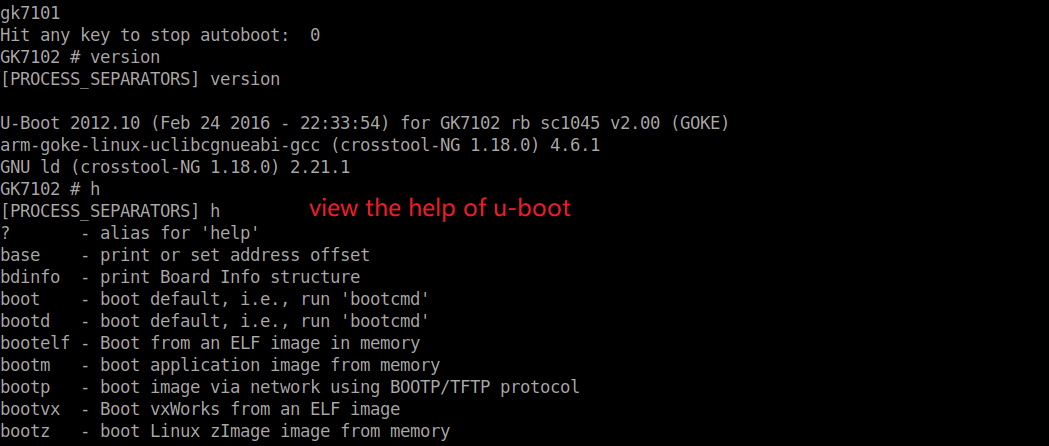


To boot that kernel without an initrd image, When booting a Linux kernel which requires a flat device-treeĪ third argument is required which is the address of theĭevice-tree blob. 'arg' can be the address of an initrd image boot application image stored in memory The following U-Boot commands illustrate loading a Linux image from a SD card using either individual images and a FIT image using the bootm command. The standard Linux build process builds the wrapper uImage and Petalinux projects generates by default the multi component FIT image as well. This command can be used either to boot legacy U-Boot images or new multi component images (FIT) as documented in U-Boot images wiki page. Linux) which expects those images be wrapper with a U-Boot specific header using mkimage. Authentication and Decryption in Zynq U-BootThe authentication and decryption feature present in Zynq U-Boot can be found at page Authentication and Decryption in Zynq u-bootĪuthentication and Decryption in ZynqMP U-BootThe authentication and decryption feature present in ZynqMP U-Boot can found at Authentication and Decryption in Zynq US+ u-bootīoot application imagesU-Boot provides bootm command to boot application images (i.e. The read command at the end just to ensure the data was written properly and you can use cmp command for comparing written data with original data which was lready present in DDR.Ĭp.b. The command sequence for nand is same as QSPI except the commands.Below nand command sequence for writing an image to nand device. Here is an example of loading an image file to nand device. Uboot> sf read 0x800 0x0 0x2000 Programming NAND Flash U-Boot provides the nand command to program nand devices. NOTE: The "destination address" should not be ZERO. Following is the syntax of the "sf read" command. U-Boot read command can be used to see what is programmed in to QSPI memory. Write from DDR address 0x08000000 to QSPI offset 0 with 0x3E444 bytes of data
#LINUX U BOOT TUTORIAL DOWNLOAD#
# Ready for binary (kermit) download to 0x08000000 at 115200 bps. it is assumed that you should have a boot image generated using the bootgen utility load the boot image through KERMIT protocol after this step load method can be KERMIT through UART, XMD dow -data through JTAG, TFTP through Ethernet u-boot is at 0x04000000.Ġ8000000: ffffffff ffffffff ffffffff ffffffff. you can use any location in DDR as destination. Read QSPI Flash from 0x0 to DDR 0x08000000 with 100 bytes Note: If erase size is less than QSPI Flash page size, u-boot reports erase error To make QSPI clock run faster, higher speed can be set to second parameter, SF: Detected N25Q128 with page size 256, total 16 MiBġ6384 KiB N25Q128 at 0:0 is now current device
#LINUX U BOOT TUTORIAL UPDATE#
Sf update addr offset len - erase and write 'len'bytes from memory at 'addr' to flash at 'offset Sf erase offset len - erase 'len' bytes from 'offset' '+len' round up 'len' to block size Sf write addr offset len - write 'len' bytes from memory at 'addr' to flash at 'offset' Sf read addr offset len - read 'len' bytes starting at 'offset' to memory at 'addr' Sf probe cs] - init flash device on given SPI bus and chip select Here is an example of loading an image file to QSPI device. On all Xilinx platforms from u-boot, you can use SF command to program a QSPI device.
#LINUX U BOOT TUTORIAL SERIAL#
Programming QSPI Flash U-Boot provides the SF command to program serial flash devices. Tftpboot- boot image via network using TFTP protocol Run - run commands in an environment variable Rarpboot- boot image via network using RARP/TFTP protocol Protect - enable or disable FLASH write protection Ping - send ICMP ECHO_REQUEST to network host Nfs - boot image via network using NFS protocol Mm - memory modify (auto-incrementing address)

Loady - load binary file over serial line (ymodem mode) Loads - load S-Record file over serial line Loadb - load binary file over serial line (kermit mode) Itest - return true/false on integer compare Imxtract- extract a part of a multi-image Iminfo - print header information for application image Bootd - boot default, i.e., run 'bootcmd'īootm - boot application image from memoryīootp - boot image via network using BOOTP/TFTP protocolĬoninfo - print console devices and informationĮxt2load- load binary file from a Ext2 filesystemĮxt2ls - list files in a directory (default /)įatinfo - print information about filesystemįatload - load binary file from a dos filesystemįatls - list files in a directory (default /)įdt - flattened device tree utility commands


 0 kommentar(er)
0 kommentar(er)
